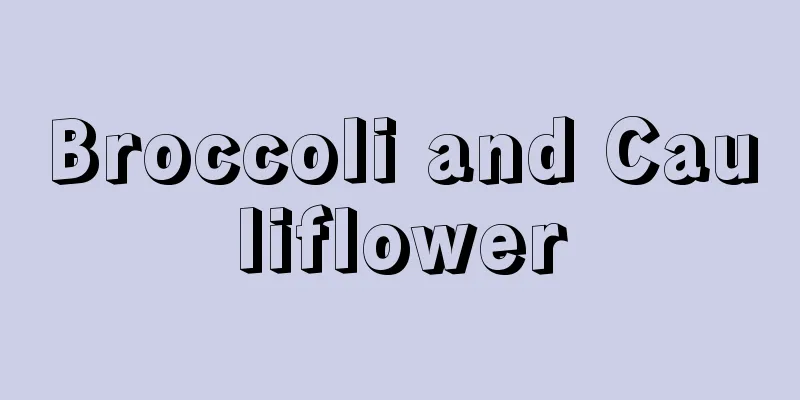Broccoli and Cauliflower

|
Broccoli and cauliflower are both common vegetables in people's lives. Because the shapes of these two vegetables are similar, many people cannot distinguish between them. The nutritional content of the two is not the same, and their effects on the human body are also different. When people need to use broccoli or cauliflower as dietary raw materials, they need to be able to distinguish between the two. Here we will introduce in detail the differences between broccoli and cauliflower. The difference is that broccoli contains slightly less carotene, vitamin A, water, sodium, magnesium, selenium and copper than cauliflower, but higher levels of protein, carbohydrates and other substances than cauliflower. Both types of cauliflower are rich in nutrients, including protein, carbohydrates, fiber, minerals, carotene and vitamin A. However, broccoli contains more nutrients than cauliflower, most notably carotene and vitamin A. The carotene and vitamin A contained in every 100 grams of broccoli are more than 200 times that of cauliflower. The water, sodium, magnesium, selenium and copper contained in every 100 grams of broccoli are slightly less than that of cauliflower, while the content of other items such as protein and carbohydrates are slightly higher than that of cauliflower. In addition, it is worth mentioning that the vitamin C content of broccoli is 51 mg per 100 grams, while the vitamin C content of cauliflower is 61 mg per 100 grams. Therefore, the commonly held belief that broccoli has the highest vitamin C content is not true, but compared with other vegetables, the vitamin C content of both is still among the highest among vegetables. Additional information: Broccoli, also known as green cauliflower, is a 1-2 year old herb native to the eastern Mediterranean coastal areas. It is currently cultivated in both the north and south of my country and has become one of the main daily vegetables. Broccoli is rich in nutrients, containing protein, sugar, fat, vitamins and carotene. Its nutritional content ranks first among similar vegetables and it is known as the "crown of vegetables". A variety of Brassica oleracea in the Cruciferae family that produces green curds. It is native to Italy along the Mediterranean coast of Europe and was introduced to China during the Guangxu period. The nutrients in broccoli are not only high in content but also very comprehensive, mainly including protein, carbohydrates, fat, minerals, vitamin C and carotene. According to analysis, every 100 grams of fresh broccoli contains 3.6 grams of protein, which is three times that of cauliflower and four times that of tomatoes. In addition, the vitamin A content is more than 100 times higher than that of cabbage. The mineral composition of broccoli is also very comprehensive. The content of calcium, phosphorus, iron, potassium, zinc, manganese, etc. is very rich, which is comparable to cauliflower, which belongs to the same cruciferous family. Broccoli ranks first in average nutritional value and disease prevention effect. Every 100 grams of cooked broccoli contains 90.6% water, 2.9 grams of protein, 5.1 grams of carbohydrates, and 117.2 kilojoules of calories. Cooked broccoli contains vitamin C, potassium, folate, vitamin A, magnesium, pantothenic acid, iron and phosphorus. In addition, broccoli also contains carotene. Broccoli can effectively reduce the incidence of breast cancer, colorectal cancer, stomach cancer, heart disease and stroke, and also has the effect of killing bacteria and preventing infection. Perhaps the most significant effect of broccoli is its anti-cancer and anti-cancer effects. Cauliflower contains more vitamin C than Chinese cabbage, tomatoes, and celery. It is especially effective in preventing and treating gastric cancer and breast cancer. Studies have shown that when suffering from gastric cancer, the level of serum selenium in the human body decreases significantly, and the concentration of vitamin C in gastric juice is also significantly lower than that of normal people. Cauliflower can not only supplement a certain amount of selenium and vitamin C, but also provide rich carotene, which can prevent the formation of precancerous cells and inhibit the growth of cancer. |
>>: What to eat to eliminate spots
Recommend
How to make colorful juice jelly
Health is extremely important to each of us, and ...
How to make old-fashioned bread rolls
Many people complained that the food was bad, so ...
How to make fresh tofu
People cannot live without food, clothing, housin...
Simple recipes from Northeast China
Northeastern cuisine is generally simpler and can...
How to make Meiling porridge
The deterioration of living environment and the i...
How to make konjac pickled pepper chicken
Cooking seems so simple in the eyes of many peopl...
How to make Malan fried rice cake
Travel regularly as a reward to yourself. Going o...
How to make Italian spaghetti
When we were young, our mother was around and we ...
Lemon brown sugar drink recipe
Eating is the most basic need for a person to sur...
How to make Eight Treasure Sweet Rice
Many people are the only child in their families,...
How to make stir-fried pork liver with pickled pepper and black fungus
Eating is very important for a person because it ...
How to make bird's nest wonton
People die for money and birds die for food. Alth...
How to make vermicelli pot?
Using kitchen utensils such as casserole pots to ...
How to make bean-flavored fruit dumplings
Many people don’t know how to cook, which is norm...
How to make spicy fried pumpkin
We often say that illness comes from the mouth, a...









